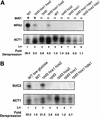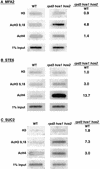Ssn6-Tup1 interacts with class I histone deacetylases required for repression
- PMID: 11069890
- PMCID: PMC317033
- DOI: 10.1101/gad.829100
Ssn6-Tup1 interacts with class I histone deacetylases required for repression
Abstract
Ssn6-Tup1 regulates multiple genes in yeast, providing a paradigm for corepressor functions. Tup1 interacts directly with histones H3 and H4, and mutation of these histones synergistically compromises Ssn6-Tup1-mediated repression. In vitro, Tup1 interacts preferentially with underacetylated isoforms of H3 and H4, suggesting that histone acetylation may modulate Tup1 functions in vivo. Here we report that histone hyperacetylation caused by combined mutations in genes encoding the histone deacetylases (HDACs) Rpd3, Hos1, and Hos2 abolishes Ssn6-Tup1 repression. Unlike HDAC mutations that do not affect repression, this combination of mutations causes concomitant hyperacetylation of both H3 and H4. Strikingly, two of these class I HDACs interact physically with Ssn6-Tup1. These findings suggest that Ssn6-Tup1 actively recruits deacetylase activities to deacetylate adjacent nucleosomes and promote Tup1-histone interactions.
Figures




Similar articles
-
Histone-dependent association of Tup1-Ssn6 with repressed genes in vivo.Mol Cell Biol. 2002 Feb;22(3):693-703. doi: 10.1128/MCB.22.3.693-703.2002. Mol Cell Biol. 2002. PMID: 11784848 Free PMC article.
-
Tup1-Ssn6 interacts with multiple class I histone deacetylases in vivo.J Biol Chem. 2003 Dec 12;278(50):50158-62. doi: 10.1074/jbc.M309753200. Epub 2003 Oct 2. J Biol Chem. 2003. PMID: 14525981
-
The Set2 methyltransferase associates with Ssn6 yet Tup1-Ssn6 repression is independent of histone methylation.Biochem Biophys Res Commun. 2006 Jan 20;339(3):905-14. doi: 10.1016/j.bbrc.2005.11.103. Epub 2005 Nov 28. Biochem Biophys Res Commun. 2006. PMID: 16329992
-
Transcriptional repression by Tup1-Ssn6.Biochem Cell Biol. 2006 Aug;84(4):437-43. doi: 10.1139/o06-073. Biochem Cell Biol. 2006. PMID: 16936817 Review.
-
Turning genes off by Ssn6-Tup1: a conserved system of transcriptional repression in eukaryotes.Trends Biochem Sci. 2000 Jul;25(7):325-30. doi: 10.1016/s0968-0004(00)01592-9. Trends Biochem Sci. 2000. PMID: 10871883 Review.
Cited by
-
Stabilization of the promoter nucleosomes in nucleosome-free regions by the yeast Cyc8-Tup1 corepressor.Genome Res. 2013 Feb;23(2):312-22. doi: 10.1101/gr.141952.112. Epub 2012 Nov 2. Genome Res. 2013. PMID: 23124522 Free PMC article.
-
Roles of TUP1 in switching, phase maintenance, and phase-specific gene expression in Candida albicans.Eukaryot Cell. 2002 Jun;1(3):353-65. doi: 10.1128/EC.1.3.353-365.2002. Eukaryot Cell. 2002. PMID: 12455984 Free PMC article.
-
Pf1, a novel PHD zinc finger protein that links the TLE corepressor to the mSin3A-histone deacetylase complex.Mol Cell Biol. 2001 Jul;21(13):4110-8. doi: 10.1128/MCB.21.13.4110-4118.2001. Mol Cell Biol. 2001. PMID: 11390640 Free PMC article.
-
Genetic analysis argues for a coactivator function for the Saccharomyces cerevisiae Tup1 corepressor.Genetics. 2021 Oct 2;219(2):iyab120. doi: 10.1093/genetics/iyab120. Genetics. 2021. PMID: 34849878 Free PMC article.
-
A region of the nucleosome required for multiple types of transcriptional silencing in Saccharomyces cerevisiae.Genetics. 2011 Jul;188(3):535-48. doi: 10.1534/genetics.111.129197. Epub 2011 May 5. Genetics. 2011. PMID: 21546544 Free PMC article.
References
-
- Allis CD, Glover CV, Bowen JK, Gorovsky MA. Histone variants specific to the transcriptionally active, amitotically dividing macronucleus of the unicellular eucaryote, Tetrahymena thermophila. Cell. 1980;20:609–617. - PubMed
-
- Bartel PL, Fields S. Analyzing protein–protein interactions using two-hybrid system. Methods Enzymol. 1995;254:241–263. - PubMed
-
- Brownell JE, Allis CD. Special HATs for special occasions: Linking histone acetylation to chromatin assembly and gene activation. Curr Opin Genet Dev. 1996;6:176–184. - PubMed
-
- Carlson M. Genetics of transcriptional regulation in yeast: Connections to the RNA polymerase II CTD. Annu Rev Cell Biol. 1997;13:1–23. - PubMed
-
- Carmen AA, Rundlett SE, Grunstein M. HDA1 and HDA3 are components of a yeast histone deacetylase (HDA) complex. J Biol Chem. 1996;271:15837–15844. - PubMed
Publication types
MeSH terms
Substances
Grants and funding
LinkOut - more resources
Full Text Sources
Molecular Biology Databases
